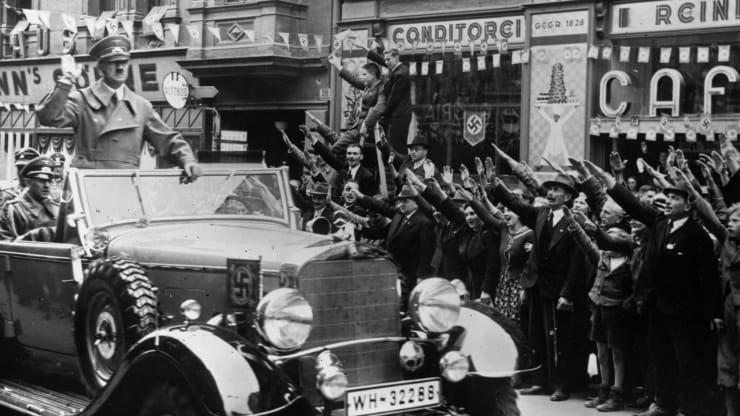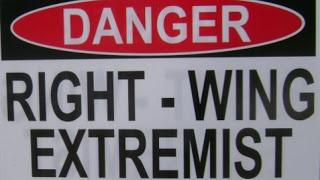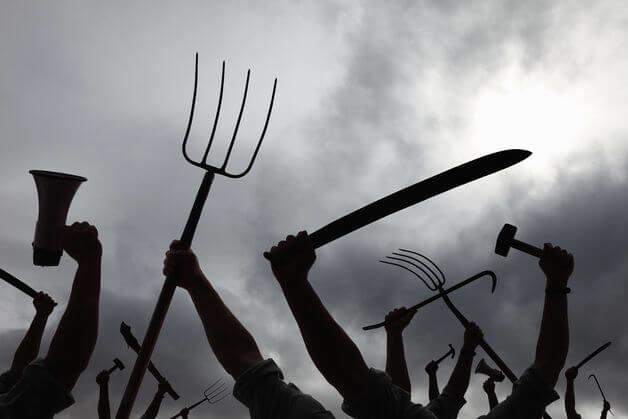Fed Study Ties 1918 Flu Pandemic To Rise Of “Right Wing Extremist” Nazi Party
Well, as TargetLiberty.com’s Robert Wenzel notes, this is quite a justification for more government spending and for keeping an eye on “right-wing extremists.”
[tl;dr] – High death tolls from the 1918 influenza pandemic likely helped the Nazis gain power in “crucial” German elections, according to new research from The Fed.
In a staff report published on Monday, researchers from the Federal Reserve Bank of New York found that German regions with higher mortality rates from the virus had a higher vote share for the Nazi Party in the elections of 1932 and 1933.
Politico sets the scene:
A new academic paper produced by the Federal Reserve Bank of New York concludes that deaths caused by the 1918 influenza pandemic “profoundly shaped German society” in subsequent years and contributed to the strengthening of the Nazi Party.
The paper, published this month and authored by New York Fed economist Kristian Blickle, examined municipal spending levels and voter extremism in Germany from the time of the initial influenza outbreak until 1933, and shows that “areas which experienced a greater relative population decline” due to the pandemic spent “less, per capita, on their inhabitants in the following decade.”
The paper also shows that “influenza deaths of 1918 are correlated with an increase in the share of votes won by right-wing extremists, such as the National Socialist Workers Party” in Germany’s 1932 and 1933 elections.
Together, the lower spending and flu-related deaths “had a strong effect on the share of votes won by extremists, specifically the extremist national socialist party” – the Nazis – the paper posits.
“This result is stronger for right-wing extremists, and largely non-existent for left-wing extremists.”
Perhaps Kristian Blickle, the author of the paper, should take a look closer to home – as in central bank money printing as a cause of social unrest.
This might be of interest to him:
The greatest inflation in the history of Germany occurred mainly from 1919-1923, but in fact it had already started in 1914, with the outbreak of WWI. When the war began, the German governments increased the money supply in order to cover the soaring costs, initially of the war itself, and afterwards, of the heavy reparations that the Allies had imposed on Germany in the Treaty of Versailles. One means of increasing the supply of money was the issue of war bonds purchased by many citizens. At the same time, it was decided to cut the linkage between the German mark and the price of gold, a connection that existed at the time in most advanced nations. The result was an expanding gap between the value of gold-based currency (the gold mark, which was actually in use until the end of the days of the German Empire) and paper currency, which could be printed in almost unlimited quantities. Flooding the market with printed money rapidly lowered its value, so that the prices rose disproportionately, while the real wage of salaried workers fell sharply.
At the same time, loans and debts lost their value by the same proportion…
This situation took its toll on the daily life of most citizens. The rise in prices that the consumer was required to pay was not matched by a rise in wages. Since wages rose more gradually, it was more difficult to keep up with the high prices…
In November 1923, the inflation reached a peak: one dollar was worth 4,200 billion German marks…Following this, the German economy recuperated over the coming years, but millions of citizens lost their capital, which had been deposited in savings plans.
Now which is more likely to spark social unrest and a dissonant desire for “someone to do something”? An extraneous flu pandemic or a government-enabled hyperinflation?
Of course, it didn’t take long for various establishment types to jump on these “findings”…
Research from British thinktank the Royal United Services Institute has warned that far-right groups and individuals are exploiting the Covid-19 crisis by “promoting disinformation and conspiracy theories to enhance their anti-immigrant or anti-government agendas and attract a new range of followers.”
Speaking to CNBC’s “Squawk Box Europe” in April, Tina Fordham, head of global political strategy at Avonhurst, said she was concerned that the pandemic could see a fresh emergence of support for extreme nationalist ideologies in Europe.
“The risk here is really a return to populism, which a few years ago was something we were all very concerned about,” she said.
“And that focus on a national self-interest is going to pave the way for the return of the (Matteo) Salvinis and others who are waiting in the wings for this.”
However, Pushan Dutt, professor of economics and political science at INSEAD, told CNBC in an interview that he did not believe the pandemic would push voters toward extreme politics.
“I think the first thing people thought about was technocratic and competent leadership,” he said.
“And I think they’re moving away from these populist politicians, whether they’re coming in from the left or coming in from the right.”
The Fed study finds that “a one std. deviation increase in the proportion of the population killed by influenza was associated with an up to 3% increase in the share of the vote won by the national socialist party,” but, as the above comments on soaring inflation (and inevitably hyperinflation) suggest the “Flu-Feeds-Nazis” theory collapses in a haze of correlation is not causation…
…but then again, bastardizing what Upton Sinclair is credited with saying “It is difficult to get a man [or woman] to understand something, when his salary [or her research grant] depends on his [her] not understanding it.”
Tyler Durden
Wed, 05/06/2020 – 13:05


